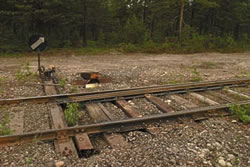BUSINESS
The Story of our Valley - Part II
Inside SCV History
March, 2006 - Issue #17
 |
After a strange turn of fortune, Henry Mayo Newhall was able to gain a significant holding in a railroad company, building lines in Northern California. After almost 10 years of work, the company was bought out by the Southern Pacific Railroad, earning Newhall a profit of well over a half-million dollars. Making his graceful exit at the high point of railroads in America, Newhall began to look for new opportunities to invest his amassing fortunes.
Within the next nine years, Newhall purchased almost 150,000 acres of land scattered among five ranches in Central California. One of these purchases was for a small valley north of the Mission San Fernando Rey de Espana, a valley aptly named Saint Clara, since it was discovered on August 12, Saint Clara's Day.
Famed Spanish explorer Don Gaspar de Portola discovered the Santa Clara Valley while settling California in the late 18th century. After spending a short time with the Tataviam Indians living there, and camping along Kashtuk (Castaic) Creek, Portola proceeded west to the ocean, never to return.
| "Plucking onions as requested by his wife, Don Francisco Lopez discovered the first of California's gold in 1842." |
Antonio Del Valle was a legend in the early mission days of California. He had been assigned to the Spanish Army, in charge of protecting the missions against pirate raiders. He eventually worked his way up to becoming administrator of the Mission San Fernando. Taking a keen interest in the Santa Clara Valley, he retired from his command, giving the job to the Lopez family, one of the founding families of Los Angeles. He married one of the Lopez daughters (Del Valle's second marriage) and moved into the mission outpost. In January 1839, he received the land grant for the entirety of the valley, extending 18 miles towards the coast (present-day Fillmore).
Travelers and family members often visited the ranch (now called Rancho San Fernando) on their transition through. One of these visitors was Don Francisco Lopez, uncle to Del Valle's wife. He was riding around the valley and stopped for lunch with his native companion. Plucking onions as requested by his wife, Francisco discovered the first of California's gold in 1842. This discovery started quite a local gold rush once the news spread all the way to Mexico City. The valley was named Placeritos (Little Placers) after all the mining that went on there. Del Valle's son later went onto to serve in the California Legislature and won election as Los Angeles County's first recorder.
--------------------------------------------------------------
Much of the research for this article came from "A California Legend: The Newhall Land and Farming Company," by Ruth Waldo Newhall.
|
||||||||||||||||||||||||||||





